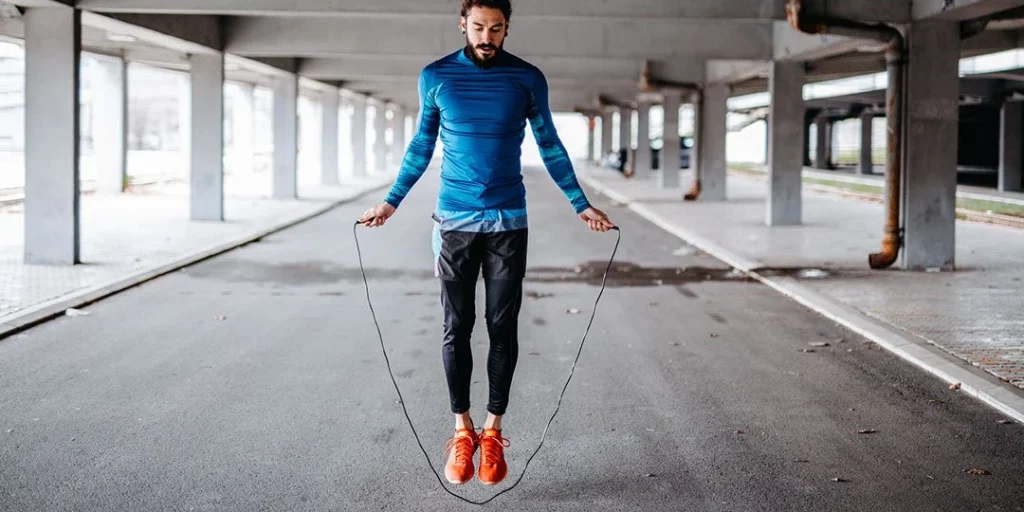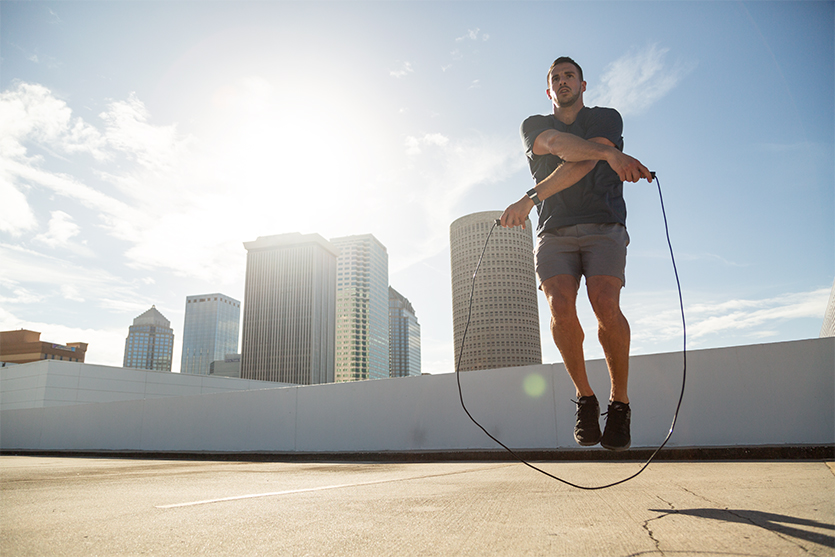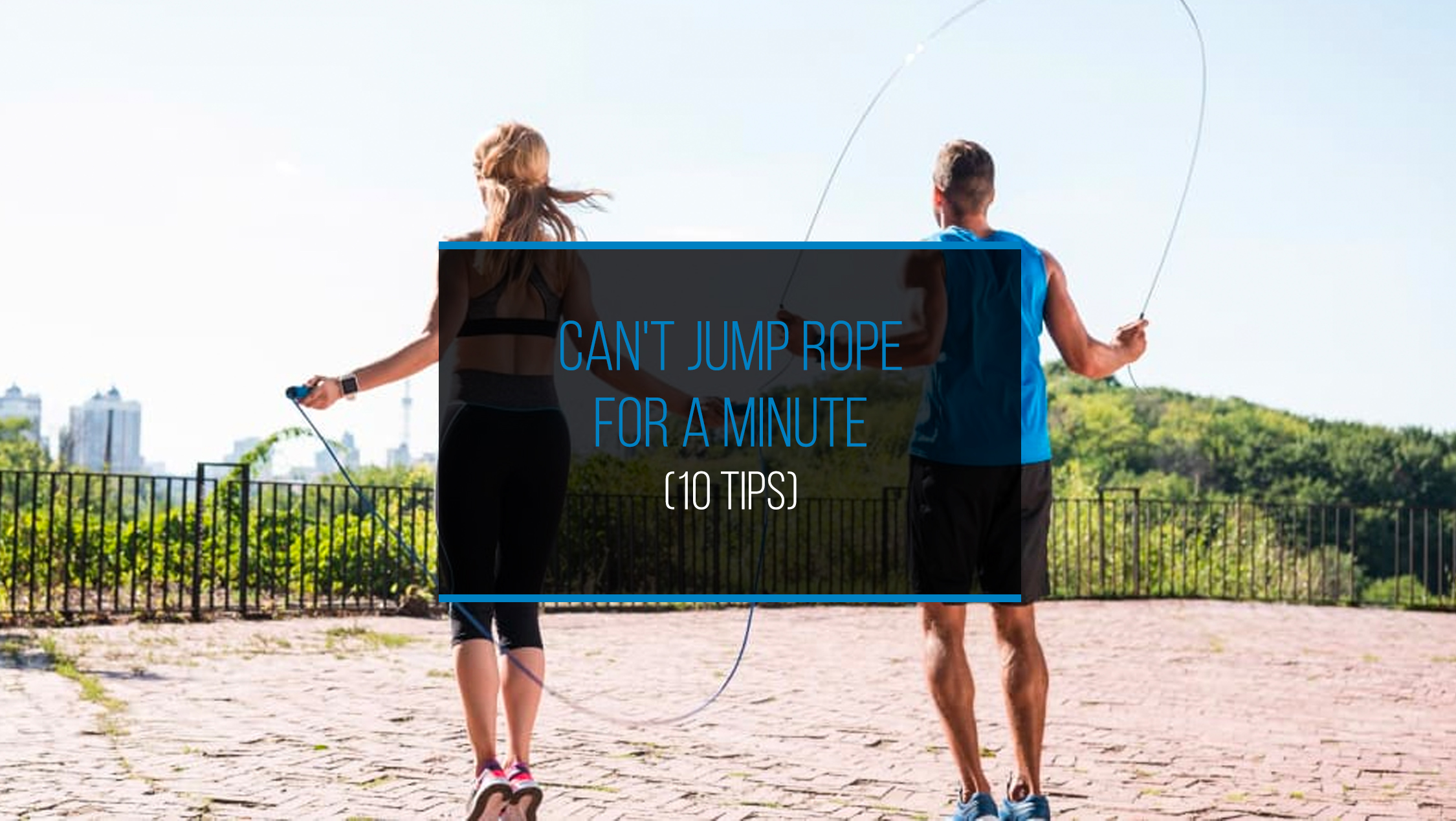Jumping rope is a simple yet extremely effective way to get fit, build strength, and improve balance and coordination.
As with any form of exercise, it’s only natural that people want to take things to the next level by increasing duration and intensity. One of the main targets for many beginners is to reach a minute, and although this might sound simple, it can take time and practice.
There might also be a simple reason why a person can’t jump rope for a minute and has to keep stopping, such as incorrect posture or because the rope is the wrong length.
If you’re struggling to jump rope for a minute, fear not because we have all the tips and information to fix any problems that might be holding you back.

The Benefits of Jumping Rope
Before we get into how to jump rope longer, let’s look at the benefits you could expect from jumping rope regularly and increasing workout lengths over time.
- Potential Weight Loss. Jumping rope regularly and for a sustained period increases the number of calories you burn, which in turn, burns fat and, if incorporated with a healthy lifestyle, can lead to weight loss.
- Cardio Benefits. Jumping rope is a repetitive movement that increases the heart rate and is classed as a cardio workout. This kind of cardio workout has many health benefits, including increased heart strength, greater lung capacity, and improved sleep.
- Increased Muscle Strength. When you regularly jump rope, you can increase strength in various muscles throughout the body. It’s especially good for the shoulders, biceps, calves, and thighs.
- Healthy Joints. If performed correctly, the motion of jumping rope can help strengthen joints and keep them healthy. Stronger muscles also help protect joints and can reduce the risk of injury.
- Improved Posture. Jumping rope can help improve posture by strengthening the muscles in the shoulders, which can be a problem area.
How to Jump Rope Longer
1. Keep Your Elbows In
One of the most important things to remember when jumping rope is to keep the elbows in and not have your arms too wide apart.
Having your arms too wide apart can cause the rope to shorten and catch on your legs or feet, which will stop the momentum of the rope.
To ensure the rope swings correctly and doesn’t snag, use your wrists to turn the rope rather than your elbows and make sure each arm is the same distance apart.
When jumping rope, the arms should be straight and close to the body with the hands out and in line with the hips so you can turn from the wrists.
By making these simple changes to arm positioning, you can jump rope longer without stopping due to rope issues.
2. Check Your Rope Length
When it comes to the length of your jump rope, there isn’t a one-fits-all approach because the length will depend on your height.
As a general rule, a jump rope should be three feet longer than your height (not including the handles). For example, your rope should measure around eight feet eight inches if you’re five feet eight inches.
If your rope is too long or too short, it will keep catching on your feet or legs, causing you to stop jumping and preventing you from reaching your target of jumping for a minute or more.
You can buy different length ropes, and many can be adjusted to suit your height. If you can, test the rope before purchasing to ensure it’s the right length and check that it can be adjusted.
Don’t forget that footwear can add more height, so try or adjust the rope while wearing the shoes you’ll use during training.
3. Don’t Go Too Fast
Another reason why some people struggle to sustain jumping momentum for a minute or more is because they’re going too fast.
If you don’t have a steady, fluid motion, this can cause your hand movements and jumps to become erratic, which can lead to stopping and starting as the rope catches on your body.
Try to maintain a steady motion while in the beginner stage of jumping rope without trying to go too hard too soon. You will get a good cardio workout whatever the speed, and maintaining the motion is more important than going too fast.
Some people use music or counting to maintain a steady speed and motion — give these a try to see what works best for you.

4. Check Your Posture
Good posture is also important for maintaining motion while jumping rope and can help you to jump longer.
One of the biggest mistakes people make when jumping rope is looking down at their feet, which leads to incorrect posture.
Although it can be tempting to look down, you need to keep your chin up and face forward, looking directly in front of you.
Stand with the back straight and chest out, with legs close together and arms in the correct position (see tip one).
By maintaining correct posture and jumping rope regularly, you can expect to see improvements in balance, coordination, and stability.
5. Bounce Consistently
A common mistake people make when jumping rope is the assumption that you need to jump as high as possible to get the maximum benefits out of a workout. The best way to jump (or bounce) when jumping rope is to stay low to the ground and lift just enough that the rope can pass smoothly under the feet with each rotation.
Keeping the bounce low to the ground reduces the amount of impact you put into the jump. This will help prevent strain and injury to the joints (mainly the knees, ankles, and hips).
It’s important to note that there’s a fine line between jumping low and maintaining enough height to allow the rope to pass under the feet without the rope catching, which can cause you to trip. Getting the right bounce takes practice, but the benefits are worth it in the long term.
6. Use Intervals
When you’re just starting out with jumping rope, getting to a minute can be made easier by using reps to build up cardio fitness levels and strength that can help you build up endurance to jump longer.
A good way to do this is by using reps to split out your training and take a small break between each one. For example, start with ten seconds, rest for ten and then do another ten.
Increase the length of each set once you’re confident you can maintain the jump longer until you can comfortably go for a minute without stopping.
You can use this interval method and the other tips in this article to increase your jump time to well over a minute to extend the cardio and strength-building benefits you get from a long workout.
7. Make Sure You’re Using the Right Rope
Although traditionally, a jump rope was indeed a rope, modern-day versions are generally cable-type ropes covered in a plastic coating.
Cable ropes work well because they’re weightier and help sustain a smooth and fluid motion during a jump rope workout. They’re also thinner, so they can pass more easily under the feet without you having to jump too high, reducing the strain you put on your joints.
There are various kinds of rope that you can choose from, including weighted ropes that increase resistance and strength-building potential or digital ropes that track data such as calories burned, the number of rotations, and time spent working out.
If you’re a beginner at jumping rope or struggling to maintain motion, we recommend using a basic cable-style rope with handles that are comfortable for your grip.
8. Build Strength and Endurance
The beauty of jumping rope is that it’s great for beginners and doesn’t take a huge amount of strength to perform. However, it can help if you’re already fairly fit because jumping rope can quickly make you feel fatigued if you’ve not done it before.
You will find it easier to jump rope for a minute or longer if you’ve built up the strength and endurance to do so.
Although you don’t have to be physically strong to jump rope, people who already have a degree of muscle strength through other forms of exercise often find it easier to train longer.
If you’re struggling to jump rope for a sustained period, you might find it easier to build up some muscle strength by performing an exercise focusing on muscle groups in the shoulders and legs, such as swimming or rowing.
Building strength in these areas also helps maintain healthy joints and can reduce the risk of joint strain when you jump rope regularly.
9. Focus On Quality, Not Quantity
We’ve touched on this point when talking about not going too fast. Rushing or putting pressure on yourself to do more can lead to frustration, which in turn can lead to bad habits such as incorrect posture and bounce motion. These things can be counter-productive in helping you reach your goals.
When you start, try focusing more on finding the perfect motion rather than worrying about timing. Once you perfect the move’s quality, the workout’s duration will greatly improve without you having to try too hard to get there.
It will help if you can watch and absorb as many expert videos as possible to understand how to perfect your posture and motion.
10. Practice
The final and probably most important tip to help you sustain your rope jump without stopping is practice.
Although it can be frustrating in the beginning if you need to keep stopping and starting the jump rope motion, the only way you can get better is by trying and failing over and over again.
With patience and practice, you will get better at sustaining the motion, which will help you easily reach your goal of being able to jump rope for a whole minute. Once you can effortlessly maintain the rhythm for a minute, you can increase it to two, three, four, or five minutes.

How Long Should You Jump Rope For?
There are no hard and fast rules on how long you should jump rope for, but it’s important not to overdo things and to build up the length of your workouts over time.
Jumping rope is generally considered a shorter workout than other forms of exercise because it’s pretty intense, and most people struggle to maintain it for a long time.
Once you build the endurance you need for a longer workout, you can progressively increase your session’s length over time.
Start by aiming for five minutes, three or four times per week, and when you’re ready, increase to ten and then fifteen minutes.
Some people do more than fifteen minutes and progress to 20 or thirty minutes. However, this is considered a long workout, and it takes time to progress to these levels.
Conclusion
So to summarise everything you need to remember to jump rope perfectly and increase the time you can sustain motion:
- Maintain the correct posture and arm positioning to prevent the rope from catching your body, causing you to stop.
- Choose a rope that’s the right length for you and comfortable for your grip. Start with a basic rope.
- Keep your bounce consistent, don’t go too fast, and keep your bounce low to the ground to avoid joint strain.
- Try using intervals to build up endurance levels and your ability to sustain the motion longer.
- Focus on quality movement to maintain motion.
- Remember that practice makes perfect, and the more you practice, the longer you’ll be able to jump rope over time.
The experts make jumping rope look simple, but the truth is they probably started out making the same mistakes as everyone else. Bringing all of these things together will help you to jump rope like a pro, get the most benefits from your workout, and will help expand your moves over time.

